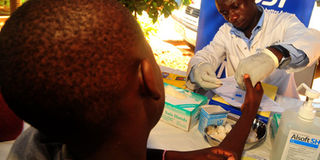Stigma reversing gains in Aids war - Besigye

A health worker conducts an HIV/Aids test on a child. File photo
What you need to know:
The effect of the stigma and discrimination that has been generated in our society has only served to drive the vulnerable sections underground and to generally undermine the necessary behavioural changes.
I convey my gratitude to all those who have been, in one way or another, engaged in responding to the global HIV/Aids epidemic. I also wish to make observations and suggestions regarding Uganda’s national response.
It’s been about 33 years since HIV/Aids was first recognised as a human disease. Presently, more than 40 million people globally are infected with the HIV virus and a similar number has died from the disease. The World Health Organisation (WHO) has presented some good news that globally, the spread of the disease and Aids-related deaths have declined, though still quite worrisome.
Regrettably, in Uganda, the spread of HIV is on the increase. Uganda and Chad are the only African countries with this sad situation. Presently, about 1.4 million people live with HIV in Uganda; including about 200,000 children.
Those infected, who are between 15 and 49 years, have increased from 6.4 per cent to 7.3 per cent (this is higher for women at 8.3 per cent)! This means that in this age group, seven to eight people are infected in every 100 people. On Saturday, November 30, I heard several local FM stations give the wrong figure as 7 people in 1,000 that are infected.
It means that we are not providing an effective response to the HIV epidemic. Uganda Aids Commission (UAC) is the body set up by government to oversee, plan and coordinate response to HIV/Aids. It’s board and secretariat are appointed by the President. We have a whole industry of HIV/Aids-related NGOs, FBOs, and CBOs numbering over 1,000 under the loose umbrella coordination of Uganda Network of Aids Services Organisation (UNASO); Networks for persons living with HIV (PLHIV); several international organisations and alliances between these and local ones.
Causes of failed response
Huge amounts of resources have been committed to the fight against HIV/Aids in Uganda. The US government alone, under the Presidential Emergency Plan for Aids (PEPFAR) has spent close to $2 billion. The Global Fund (to fight Aids, TB and Malaria) has spent about $500 million. Although the funding from the Uganda government has been minuscule (5 to 10 per cent), the reversed trend of HIV spread cannot be put down to luck of resources.
There have been many and varied analyses of the Ugandan reversal of HIV/Aids spread. I still get the sense that there is no clarity on the causes of the failed response. In the circumstances, it’s not possible to design appropriate and effective changes to the management of the epidemic. I consider that three interlinked factors have been at the centre of Uganda’s failed Aids response; namely:
• Aids-related stigma and discrimination.
• Government’s failure to respect, protect and fulfill human rights, especially civic, political, social and economic rights.
• Government policies that undermine effective HIV/Aids response.
Stigma and discrimination are possibly the most unaddressed drivers of HIV spread. The Ugandan media and HIV/Aids-related organisations made commendable effort to deal with HIV/Aids stigma and discrimination during the early-to-mid 1990s.
By the beginning of the 2000s, most of this effort had significantly waned. President Museveni was, for sometime, credited with the positive trends in Uganda’s response to HIV. He definitely helped in supporting early openness and transparency in our national response.
Some other countries tried to cover up the epidemic for fear of affecting tourism and other economic benefits. However, right from the onset, Mr Museveni consistently cultivated and nurtured Aids-related stigma and discrimination. Mr Museveni has always depicted HIV/Aids as self-inflicted, a result of reckless indiscipline, immorality etc. He gave the imagery of HIV infection as similar to being beaten by a snake if you poke your hand in every hole you see; because snakes are known to reside in holes! Before ARVs became widely available, he personally decided on who should access treatment at public expense.
When I challenged him in the 2001 presidential elections, he addressed a press conference of local and international media, saying that I was an Aids victim and that the presidency was not for invalids. To be recruited into the UPDF, Uganda Police and others areas of public employment, it was (and still is) a requirement that one gets tested and certified to be free from HIV. Those who were in service and were known or deemed to have HIV/Aids were not promoted or were laid off in retrenchment exercises.
A 2006 United Nations Research Institute for Social Development (UNRISD) programme paper entitled: “The Politics of HIV/Aids in Uganda” presents more detail on the cultivation and promotion of stigma and discrimination in Uganda. Since the coordinator and overseer of the national response to HIV/Aids, the UAC is appointed by and entirely accountable to the President (UAC Act 1992). It’s easy to see how his views permeated liberally into the national responses to HIV/Aids.
There has also been the widely drummed-up phobia against homosexual relationships. Though homosexuality and prostitution has always been criminal offences in Uganda, dating from the colonial period, hate campaign and public attack and condemnation of these sections of the Ugandan society has escalated in the last 10 years.
This seems to have coincided with US PEPFAR funding that prioritised the “morality” campaigns. There were also powerful religious crusades that targeted homosexuality and prostitution. The effect of the stigma and discrimination that has been generated in our society has only served to drive the vulnerable sections underground and to generally undermine the necessary behavioural changes.
Government’s failure to respect, protect, and fulfill human rights is the second vital challenge. The UN published 12 guidelines on HIV/Aids and human rights in 2006.
It emphasised that effective HIV/Aids response requires the implementation of all rights (civil, political, economic, social and cultural) and fundamental freedoms of the people enshrined in the international covenants; promoting a supportive environment for vulnerable groups and persons living with HIV; undertaking special measures for protection of vulnerable groups, especially women, children, sex workers, drug users and men having sex with men.
The guidelines require states to take specific measures to promote and fulfill human rights and freedoms in their national response to HIV/Aids. Most of these guidelines have not been observed in Uganda.
Human rights are based on principles of dignity and freedom; both of which are compromised if people can’t meet basic needs. Social and economic rights include right to food, housing, education, health, work, and social security. HIV and Aids thrives in situations where these conditions are severely compromised, as is the case for millions of Ugandans. Young girls who can’t afford food or tuition, who have no access to quality prevention measures and services, or adequate HIV information are more than vulnerable to HIV infection.
Civil rights include the ensuring of peoples’ physical and mental integrity, life and safety; protection from discrimination on grounds such as race, gender, national origin, colour, sexual orientation, ethnicity, religion, or disability; and individual rights such as privacy, the freedoms of thought and conscience, speech and expression, religion, the press, assembly and movement.
Political rights include natural justice (procedural fairness) in law, such as the rights of the accused, including the right to a fair trial; due process; the right to seek redress or a legal remedy; and rights of participation in civil society and politics such as freedom of association, the right to assemble, the right to petition, the right of self-defence, and the right to vote. These rights, though seemingly without direct connection to spread of HIV, are very much linked to the health status of any community. People who are despondent and hopeless are reckless.
Government policies (or absence) that undermine effective HIV/Aids response
In spite of commendable effort by the UAC to initiate an Aids Policy for Uganda since 1993, their proposals ended at the desk of their boss the President! It was not until 2011 that the then Minister for the Presidency Kabakumba Matsiko signed a document entitled Uganda National HIV and Aids Policy. Apart from those who were involved in making the “policy”, it appears that not many are aware of its existence. MPs who I have talked to have not seen it and they say that it has never been formally presented to Parliament. There is no law up to now providing for and regulating the HIV/Aids response in Uganda. The HIV/Aids Prevention and Control Bill is still being examined by the parliamentary committees.
The Bill before Parliament provides for mandatory HIV testing (especially for pregnant women, prostitution convicts, drug users), mandatory notification and disclosure and criminalises transmission. Such provisions, forming a part of the Bill 30 years into the epidemic, show that the policy makers and coordinators of HIV/Aids response (especially in the Executive arm of government) undermine the fight against HIV/Aids. Such provisions that have been widely advocated, will increase stigma and discrimination.
A President who comes to be publicly tested using his own staff, because he has no trust in the public health care system, does little to encourage others to go to public health centres for the same.
Poor funding
Government funding to the health sector has been grossly deficient. Government and “donor” funding together amount to $5 to 9 per person per year. Yet, to meet the minimum health care delivery, public sector (government) needs to spend $28 per person and up to $40 per person per year, including ARVs.
This means that government meets about 12 to 22 per cent of the basic health needs of Uganda. It’s no wonder that the entire health care delivery system has collapsed. Uganda’s HIV/Aids response is 90 per cent donor-funded. Government has been contributing 5 to 10 per cent. This means that the donors set the priorities. From about 2005, PEPFAR funding prioritised abstinence campaigns and ARV treatment.
Due to inadequate funding, only 64 per cent of the HIV infected persons who need treatment are covered. Only 49 per cent of children who need treatment are covered. Yet, in order to prevent the spread, it’s necessary that all affected people are put on ARVs, even before it becomes clinically necessary.
Apart from poor funding, NRM regime predators have been stealing and diverting huge amounts of “donor” funds for their personal use or for servicing the monstrous patronage system that props up the regime. It was following such a scandal with Global Fund’s money that the Fund suspended grants worth US$ 200 million in 2005. Suggestions have been made for setting up a special National Aids Fund (even an Aids tax). If government officials are stealing donor money, with all the checks they institute, what chance has our own fund?
In conclusion, Uganda’s response to the HIV/Aids epidemic has been mixed, but largely unsatisfactory. The political leadership that was hailed for the early successes in HIV/Aids control has been mainly responsible for the reversal in its spread. Let’s focus our effort on dealing with these challenges: stigma and discrimination; respect human rights and freedoms; and appropriate policy responses.
Dr Kizza Besigye is a former Forum for Democratic Change party president




